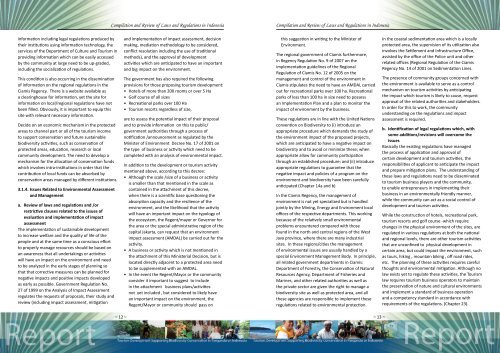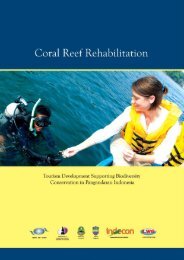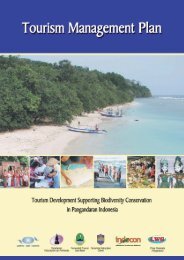Review of Laws and Regulation - unwto
Review of Laws and Regulation - unwto
Review of Laws and Regulation - unwto
- No tags were found...
You also want an ePaper? Increase the reach of your titles
YUMPU automatically turns print PDFs into web optimized ePapers that Google loves.
Compilation <strong>and</strong> <strong>Review</strong> <strong>of</strong> <strong>Laws</strong> <strong>and</strong> <strong>Regulation</strong>s in IndonesiaCompilation <strong>and</strong> <strong>Review</strong> <strong>of</strong> <strong>Laws</strong> <strong>and</strong> <strong>Regulation</strong>s in Indonesiainformation including legal regulations produced bytheir institutions using information technology, theservices <strong>of</strong> the Department <strong>of</strong> Culture <strong>and</strong> Tourism inproviding information which can be easily accessedby the community at large need to be up-graded,including the socialization <strong>of</strong> regulations.This condition is also occurring in the dissemination<strong>of</strong> information on the regional regulations in theCiamis Regency. There is a website available asa clearinghouse for information, yet the site forinformation on local/regional regulations have notbeen filled. Obviously, it is important to equip thissite with relevant necessary information.Decide on an economic mechanism in the protectedareas to channel part or all <strong>of</strong> the tourism incometo support conservation <strong>and</strong> future sustainablebiodiversity activities, such as conservation <strong>of</strong>protected areas, education, research or localcommunity development. The need to develop amechanism for the allocation <strong>of</strong> conservation fundswhich involves intra-institutions in order that thecontribution <strong>of</strong> local funds can be absorbed byconservation areas managed by different institutions.3.1.4. Issues Related to Environmental Assessment<strong>and</strong> Managementa. <strong>Review</strong> <strong>of</strong> laws <strong>and</strong> regulations <strong>and</strong> /orrestrictive clauses related to the issues <strong>of</strong>evaluation <strong>and</strong> implementation <strong>of</strong> impactassessmentThe implementation <strong>of</strong> sustainable developmentto increase welfare <strong>and</strong> the quality <strong>of</strong> life <strong>of</strong> thepeople <strong>and</strong> at the same time as a conscious effortto properly manage resources should be based onan awareness that all undertakings or activitieswill have an impact on the environment <strong>and</strong> needto be analyzed in the early stages <strong>of</strong> planning sothat that corrective measures can be planned fornegative impacts <strong>and</strong> positive impacts developedas early as possible. Government <strong>Regulation</strong> No.27 <strong>of</strong> 1999 on the Analysis <strong>of</strong> Impact Assessmentregulates the requests <strong>of</strong> proposals, their study <strong>and</strong>review (including impact assessment, mitigation<strong>and</strong> implementation <strong>of</strong> impact assessment, decisionmaking, mediation methodology to be considered,conflict resolution including the use <strong>of</strong> traditionalmethods), <strong>and</strong> the approval <strong>of</strong> developmentactivities which are anticipated to have an important<strong>and</strong> big impact on the environment.The government has also required the followingprovisions for those proposing tourism development:• Hotels <strong>of</strong> more than 200 rooms or over 5 Ha• Golf course <strong>of</strong> all sizes• Recreational parks over 100 Ha• Tourism resorts regardless <strong>of</strong> size,are to assess the potential impact <strong>of</strong> their proposal<strong>and</strong> to provide information on this to public/government authorities through a process <strong>of</strong>notification /announcement as regulated by theMinister <strong>of</strong> Environment Decree No. 17 <strong>of</strong> 2001 onthe type <strong>of</strong> business or activity which need to becompleted with an analysis <strong>of</strong> environmental impact.In addition to the development or tourism activitymentioned above, according to this decree:• Although the scale /size <strong>of</strong> a business or activityis smaller than that mentioned in the scale ascontained in the attachment <strong>of</strong> this decree,when there is a scientific base questioning theabsorption capacity <strong>and</strong> the resilience <strong>of</strong> theenvironment, <strong>and</strong> the likelihood that the activitywill have an important impact on the typology <strong>of</strong>the ecosystem, the Regent/mayor or Governor forthe area or the special administrative region <strong>of</strong> thecapital Jakarta, can request that an environmentimpact assessment (AMDAL) be carried out for theactivity.• A business or activity which is not mentioned inthe attachment <strong>of</strong> this Ministerial Decision, but islocated directly adjacent to a protected area needto be supplemented with an AMDAL.• In the event the Regent/Mayor or the communityconsider it important to suggest to includein the attachment business plans/activitiesnot yet included , but considered to likely havean important impact on the environment, theRegent/Mayor or community should pass onthis suggestion in writing to the Minister <strong>of</strong>Environment.The regional government <strong>of</strong> Ciamis furthermore,in Regency <strong>Regulation</strong> No. 9 <strong>of</strong> 2007 on theimplementation guidelines <strong>of</strong> the Regional<strong>Regulation</strong> <strong>of</strong> Ciamis No. 12 <strong>of</strong> 2005 on themanagement <strong>and</strong> control <strong>of</strong> the environment inCiamis stipulates the need to have an AMDAL carriedout for recreational parks over 100 ha. Recreationalparks <strong>of</strong> less than 100 ha in size need to possessan Implementation Plan <strong>and</strong> a plan to monitor theimpact <strong>of</strong> environment by the business.These regulations are in line with the United Nationsconvention on Biodiversity to (i) introduce anappropriate procedure which dem<strong>and</strong>s the study <strong>of</strong>the environment impact <strong>of</strong> the proposed projects,which are anticipated to have a negative impact onbiodiversity <strong>and</strong> to avoid or minimize these; whenappropriate allow for community participationthrough an established procedure; <strong>and</strong> (ii) introduceappropriate regulations to guarantee that thenegative impact <strong>and</strong> policies <strong>of</strong> a program on theenvironment <strong>and</strong> biodiversity have been carefullyanticipated (Chapter 14a <strong>and</strong> b)In the Ciamis Regency, the management <strong>of</strong>environment is not yet specialized but is h<strong>and</strong>ledjointly by the Mining, Energy <strong>and</strong> Environment local<strong>of</strong>fices <strong>of</strong> the respective departments. This workingbecause <strong>of</strong> the relatively small environmentalproblems encountered compared with thosefound in the north <strong>and</strong> central regions <strong>of</strong> the WestJava province, where there are many industrialsites. In these regions/cities the management<strong>of</strong> environmental issues are usually h<strong>and</strong>led by aspecial Environment Management Body. In principle,all related government departments in Ciamis:Department <strong>of</strong> Forestry, the Conservation <strong>of</strong> NaturalResources Agency, Department <strong>of</strong> Fisheries <strong>and</strong>Marines, <strong>and</strong> other related authorities as well asthe private sector are given the right to manage abiodiversity site as well as protected area, <strong>and</strong> allthese agencies are responsible to implement theseregulations related to environmental protection.In the coastal sedimentation area which is a locallyprotected area, the supervision <strong>of</strong> its utilization alsoinvolves the Settlement <strong>and</strong> Infrastructure Office,assisted by the <strong>of</strong>fice <strong>of</strong> the Police unit <strong>and</strong> otherrelated <strong>of</strong>fices (Regional <strong>Regulation</strong> <strong>of</strong> the CiamisRegency No. 14 <strong>of</strong> 2001 on Sedimentation Lines.The presence <strong>of</strong> community groups concerned withthe environment is available to serve as a controlmechanism on tourism activities by anticipatingthe impact which tourism is likely to cause, requestapproval <strong>of</strong> the related authorities <strong>and</strong> stakeholders.In order for this to work, the communityunderst<strong>and</strong>ing on the regulations <strong>and</strong> impactassessment is required.b. Identification <strong>of</strong> legal regulations which, withsome additions/revisions will overcome theissuesBasically the existing regulations have managedthe process <strong>of</strong> application <strong>and</strong> approval <strong>of</strong>certain development <strong>and</strong> tourism activities, theresponsibilities <strong>of</strong> applicant to anticipate the impact<strong>and</strong> prepare mitigation plans. The underst<strong>and</strong>ing <strong>of</strong>these laws <strong>and</strong> regulations need to be disseminatedto tourism business players <strong>and</strong> the community,to enable entrepreneurs in implementing theirbusiness in an environmentally friendly manner,while the community can act as a social control <strong>of</strong>development <strong>and</strong> tourism activities.While the construction <strong>of</strong> hotels, recreational park,tourism resorts <strong>and</strong> golf course -which requirechanges in the physical environment <strong>of</strong> the sites, areregulated in various regulations at both the national<strong>and</strong> regional levels, there are other tourism activitiesthat are unconfined to physical development incertain area, but could impact the environment, suchas tours, hiking , mountain biking , <strong>of</strong>f road rides,etc. The planning <strong>of</strong> these activities requires carefulthoughts <strong>and</strong> environmental mitigation. Although nolaw exists yet to regulate these activities, the Tourismlaw requires tourism business operators to maintainthe preservation <strong>of</strong> nature <strong>and</strong> cultural environments<strong>and</strong> implement a st<strong>and</strong>ard <strong>of</strong> business operation<strong>and</strong> a competency st<strong>and</strong>ard in accordance withrequirements <strong>of</strong> the regulations. (Chapter 23).~ 12 ~~ 13 ~




